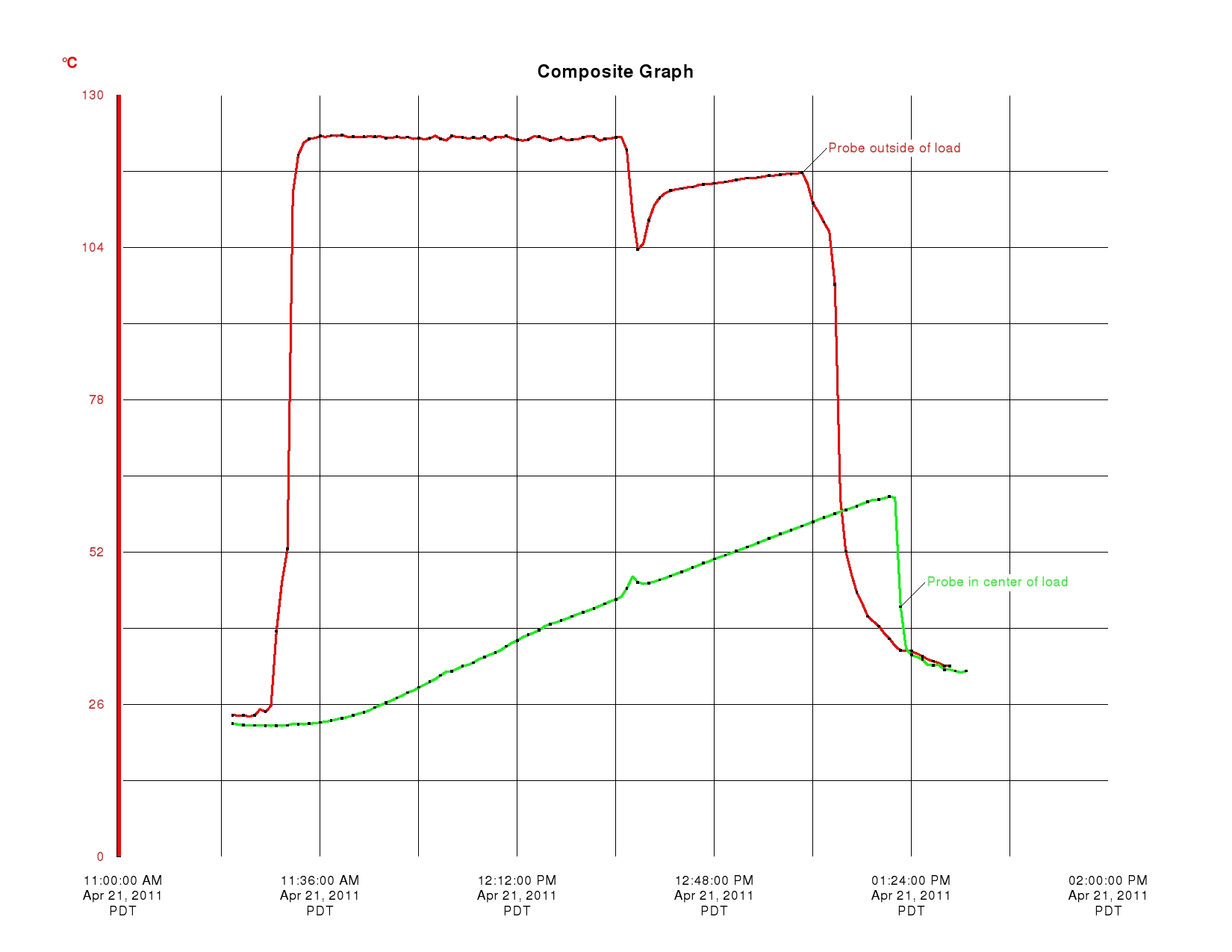
Unfortunately it is the protocol that is at fault here.
I have lost count as to how many times I have told people that you cannot sterilize sealed bags in a
gravity autoclave.
Even with vented bags it is still very difficult to sterilize bagged waste without manipulating the load.
However, it still gets done every day. A lot of these highly intelligent folks will tell me that there is no
problem and they have biological tests that prove it.
Well, they sure do have proof, but what are they testing? Since they place the bio-indicator
outside of the bag, they are only testing that the chamber itself is sterile along with the outside of the bag. Well, this is very re-assuring
since the outside of the bag is probably not even contaminated in the first place.
The red line in the graph represents the chamber temperature and basically shows that the temperature outside of the waste bag is reaching it's desired value.
The green line indicates the temperature inside of the waste bag. This is the temperature that should interest us, right? So why do these clowns continue to monitor the outside of the bag and not the contents? Do I really need a PhD to get this message across to the masses?
Here's an interesting fact - When an unprocessed BI is incubated , it typically takes around 4 hrs to show growth which is indicated by turbidity and a color change. A correctly processed BI will not show any signs of growth after several days.
When the BI from this autoclave, which had been processed for 60 mins @ 123oC, was incubated, it actually showed signs of growth in less than 2 hours!
IT IS PAINFULLY CLEAR THAT THE PROCESS ACTUALLY ASSISTED THE BACTERIAL GROWTH INSTEAD OF KILLING IT. WE WOULD HAVE BEEN BETTER OFF JUST THROWING IT IN THE DUMPSTER WITHOUT EVEN BOTHERING TO AUTOCLAVE IT. WHAT A JOKE!
 |
| The autoclave is performing to manufacturers specs. Unfortunately it is the protocol that is at fault here. |
| |
The test equipment includes a 6-log BI, a Class 5 CI and a NIST traceable Data Logger |
| |
The test pack is placed as close as possible to the geometric center of the waste load |
| The waste bag is then closed with a twist tie (this is the first 'death move') The bag is then placed inside of a red bag (this is the second 'death move') |
|
| |
What a pretty looking goose neck! I wonder what clown told them to do it this way? This is the third 'death move'. Goose neck is an appropriate name since we have now essentially put a strangle hold on any chance of removing the air from the load. If the air can't get out how do you think the steam can get in? |
| Just for fun, another BI and CI were placed outside of the waste bag but within the secondary container Another Data Logger is placed on the shelf to monitor the chamber temperature |
|
| The turkey is placed in the oven | |
| "See, I told you there was nothing to worry about! Look at my proof. I have a printout stating that the load was autoclaved for 60 mins at 123oC. How could anything possibly survive that? I'll show this to the inspectors and they'll be just tickled pink!" | |
| Oops, what's this mean? Who decided to place chemical integrators inside the bag? How can this be? Is the turkey not cooked? Should be ok, right? Perhaps we could test it on the mother-in-law? Let's inspect the CI's The top one represents the space in the secondary container outside of the bag. After 60 minutes of exposure at 123oC it should have turned completely dark. It actually got pretty close at about 95%. This can be explained by the fact that air is trapped in the secondary container. A Gravity autoclave, even after 60 minutes, is not fully capable of removing the air from this space. Now check out the CI in the second row that was placed in between the waste bag and the red bag. Pretty cool eh? It's in the 'Accept' range, yippee, but only just. Now for the nitty gritty. The bottom CI came out of the center of the waste bag. "Oh dear, that's not good". "But we've always done it like this...perhaps the CI was bad"? Well, the CI was backed up by the BI and the internal Data Logger. As mentioned earlier, more bugs grew in the BI than were destroyed. The Data Loggers have the ability to calculate the degree of lethality known as the F-Value. The DL that was placed on the shelf returned an F-Value of 91.3 units. Guess what the F-value was for the DL placed in the center of the waste? A+ if you said zero! Actually, to be more precise, it was 0.0. Perhaps we should consider using the microwave next time!! |